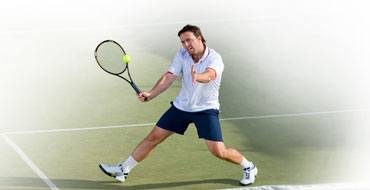Knee
Conditions
Normal Anatomy of the Knee Joint
The knee is made up of four bones. The femur or thighbone is the bone connecting the hip to the knee. The tibia or shinbone connects the knee to the ankle. The patella (kneecap) is the small bone in front of the knee and rides on the knee joint as the knee bends. The fibula is a shorter and thinner bone running parallel to the tibia on its outside. The joint acts like a hinge but with some rotation.
To know more about Normal Anatomy, Click on below tabs
Knee Osteoarthritis
Osteoarthritis, also called degenerative joint disease is the most common form of arthritis. It occurs most often in older people. This disease affects the tissue covering the ends of bones in a joint (cartilage).In a person with osteoarthritis, the cartilage becomes damaged and worn out causing pain, swelling, stiffness and restricted movement in the affected joint. This condition most commonly affects the joints in knees. Rarely, the disease may affect the shoulders, wrists and feet.
To know more about Knee Osteoarthritis, Click on below tab
Knee Ligament Tears
Ligaments are tough fibrous bands of connective tissue that support and connect adjoining bones together. These are strong, flexible structures that provide stability to the joints. The ligaments hold the bones together, in normal alignment, and prevent abnormal movements of the joint. A ligament tear is an injury of the ligament as a result of excessive force or stress over the ligament. When the external force is higher than the inherent strength of the ligament, it may cause a ligament tear. The knee ligaments are more prone to injury.
To know more about Knee Ligament Tears, Click on below tab
Meniscus Tear
Meniscus tear is the commonest knee injury in athletes, especially those involved in contact sports. A suddenly bend or twist in your knee cause the meniscus to tear. This is a traumatic meniscus tear. Elderly people are more prone to degenerative meniscal tears as the cartilage wears out and weakens with age. The two wedge-shape cartilage pieces present between the thighbone and the shinbone are called meniscus. They stabilize the knee joint and act as “shock absorbers”.
To know more about Meniscus Tear, Click on below tab
Osgood-Schlatter Disease
Osgood-Schlatter disease refers to a condition of an overuse injury that occurs in the knee region of growing children and adolescents. This is caused by inflammation of the tendon located below the knee cap (patellar tendon). Children and adolescents who participate in sports such as soccer, gymnastics, basketball and distance running are at higher risk of this disease.
To know more about Osgood-Schlatter Disease, Click on below tab
Posterior Cruciate Ligament Tear
Posterior cruciate ligament (PCL), one of four major ligaments of the knee is situated at the back of the knee. It connects the thighbone (femur) to the shinbone (tibia). The PCL limits the backward motion of the shinbone.
To know more about Posterior Cruciate Ligament Tear, Click on below tab
Runner’s Knee
Runner’s knee, also called patellofemoral pain syndrome refers to pain under and around your kneecap. Runner’s knee includes a number of medical conditions such as anterior knee pain syndrome, patellofemoral malalignment, and chondromalacia patella that cause pain around the front of the knee. As the name suggests, runner’s knee is a common complaint among runners, jumpers, and other athletes such as skiers, cyclists, and soccer players.
To know more about Runner’s Knee, Click on below tab
Knee fracture
A fracture is a condition in which there is break in the continuity of the bone. In younger individuals these fractures are caused from high energy injuries, as from a motor vehicle accident. In older people the most common cause is weak and fragile bone.
To know more about Knee fracture, Click on below tab
Knee Sprain
Knee sprain is a common injury that occurs from overstretching of the ligaments that support the knee joint. A knee sprain occurs when the knee ligaments are twisted or turned beyond its normal range causing the ligaments to tear.
To know more about Knee sprain, Click on below tab
Unstable Knee
Damage to any of these supportive structures causes the instability of the knee joint. This can be caused by sudden twisting of the knee, tears of the meniscus, ligament or capsule, osteoarthritis of the knee (wear and tear of the cushioning cartilage tissue between bones) and sports injuries. When these tissues get injured, the patella or knee cap can move out of its groove in the knee joint and lead to instability. An unstable knee causes pain, swelling, stiffness and a tendency of the joint to buckle or “give way”.
To know more about Unstable Knee, Click on below tab
Goosefoot Bursitis of the Knee
A bursa is a small fluid-filled sac found between soft tissues and bones. It lubricates and acts as a cushion to decrease friction between bones when they move. Bursitis refers to the inflammation and swelling of the bursa. Goosefoot bursitis or Pes anserine bursitis is the inflammation of the bursa present between the tendons of the hamstring muscle and the tibia (shinbone) on the inner side of the knee.
To know more about Goosefoot Bursitis, Click on below tab
Kneecap Bursitis
A bursa is a small fluid-filled sac found between soft tissues and bones. It lubricates and acts as a cushion to decrease friction between bones when they move. Bursitis refers to the inflammation and swelling of the bursa. Inflammation of the bursa in front of the kneecap (patella) is known as kneecap bursitis or prepatellar bursitis.
To know more about Kneecap Bursitis, Click on below tab
Osteonecrosis of the Knee
Osteonecrosis is a condition in which death of a section of bone occurs because of lack of blood supply to it. It is one of the most common causes of knee pain in older women. Women over the age of 60 years of age are commonly affected, three times more often than men.
To know more about Osteonecrosis, of the Knee Click on below tab
Procedures
Arthroscopy of the Knee Joint
Knee Arthroscopy is a common surgical procedure performed using an arthroscope, a viewing instrument, to look into the knee joint to diagnose or treat a knee problem. It is a relatively safe procedure and a majority of the patient’s discharge from the hospital on the same day of surgery.
To know more about Knee Arthroscopy, Click on below tabs
Knee Ligament Reconstruction
The knee is the most complex joint in the body and is formed by the articulation between the thigh bone (femur) and the shinbone (tibia). A knee cap is present over the front of the joint to provide extra protection. These bones are held together by four strong rope like structures called ligaments. Two collateral ligaments are present on either side of the knee and control the sideway movements of the knee. The other two ligaments are the anterior and posterior cruciate ligaments, ACL and PCL respectively, which are present in the center of the knee joint and cross each other to form an “X”. The cruciate ligaments control the back and forth movement of the knee.
To know more about Knee Ligament Reconstruction, Click on below tab
Total Knee Replacement
Total knee replacement, also called total knee arthroplasty, is a surgical procedure in which the worn out or damaged surfaces of the knee joint are removed and replaced with artificial parts. The knee is made up of the femur (thigh bone), the tibia (shin bone), and patella (kneecap). The meniscus, the soft cartilage between the femur and tibia, serves as a cushion and helps absorb shock during motion. Arthritis (inflammation of the joints), injury, or other diseases of the joint can damage this protective layer of cartilage, causing extreme pain and difficulty in performing daily activities. Your doctor may recommend surgery if non-surgical treatment options have failed to relieve the symptoms.
To know more about Total Knee Replacement, Click on below tabs












